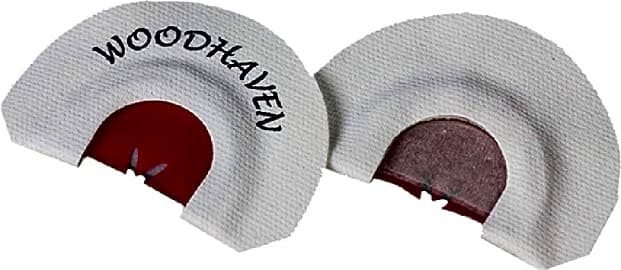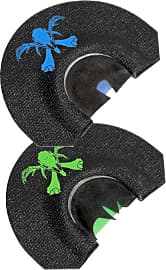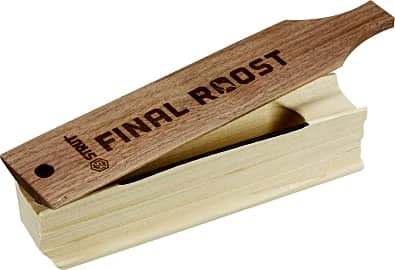The 10 Best Turkey Calls

This wiki has been updated 33 times since it was first published in October of 2017. If it's hunting season and you're thinking about going out and bagging yourself a Thanksgiving dinner, it would be wise to invest in a quality turkey call. These nifty devices allow users to imitate various bird sounds and attract prey more quickly. Our list includes models of all types, such as box, slate, and diaphragm, so you can find the perfect match for your needs. When users buy our independently chosen editorial selections, we may earn commissions to help fund the Wiki.
Editor's Notes
May 26, 2020:
Removed the Primos Jackpot, the Knight & Hale Ol' Yeller Classic, the The Gobbler Shaker, the Primos Hoot Flute, and the Hunters Specialties H.S. Strut Smokin' Gun because of availability concerns. Added the Primos Hunting Rare Breed, the Woodhaven Red Wasp, the Knight & Hale Stranglehold, the H.S. Strut Final Roost, and the Quaker Boy H2O Easy Yelper.
The easier a call is to use, the less versatile and useful it tends to be. For example, push-button-style calls like the Harmon Scents Humpin' Hen and the Quaker Boy H2O Easy Yelper are great for beginners since all you need to do is depress the dowel and it will make reliably similar calls. That of course comes at the cost of having only a few available sounds since all you can change is how far you depress each time and how quickly you do so. At the other end of the spectrum you have diaphragm calls like the Woodhaven Red Wasp and the Primos Hunting Hook. Turkeys have excellent vision, and moving down to pick up a box call or a slate call because a turkey has snuck up on you can make the difference between filling a tag or not. You'll need a lot of practice with one of these before using it to hunt - getting comfortable with it in your mouth, gauging how much pressure you need to apply with your tongue, how much air you need to move over the reeds, and many other things.
Electronic hunting calls like the Cass Creek Ergo are illegal in some areas. Check your local code or call the Department of Fish and Wildlife to ensure you're in compliance.
Attracting A Big Gobbler
By contrast, a lower-pitch sound is produced when the thinnest edge of the paddle meets the tallest area of the sides, producing a greater degree of vibration.
In addition to smell and sight, many animals leverage some form of vocal communication to alert one another to their presence. Wolves, for example, will often initiate howls to warn others of their species to stay away from their territory or to let members of their own pack know where to find them. But when it comes to humans locating animals for hunting purposes, a similar type of communication by imitation can get the animal's attention. If you're on the hunt for the next Thanksgiving turkey, and you appreciate the thrill of the hunt over picking a bird out at your local grocery store, you'll need a handy turkey call to help make the kill.
A turkey call is a device designed to reproduce the unique vocalizations these creatures make in the wild. Using the device attracts the birds out into the open, making them easy to spot when hunting. Several types of turkey calls exist and generally fall into one of two categories: friction and air-blown devices. Friction calls produce noise by rubbing two surfaces together, whereas air-blown calls rely on air pressure to vibrate internal reeds in order to accomplish the same thing.
One of the most common and popular types of turkey calls is the box call. This device is equipped with a paddle (or lid), made from a thin piece of wood that is both longer and wider than its base. At one end of the lid is a handle, while the other end is directly connected to the box by a screw. The lid is not tightened down, which allows it to swing freely back and forth. The sound produced from a box call comes from the movements of its lid across one of the sides, creating a vibration. This vibration resonates through the box and emits tonal qualities ranging from high to low, mimicking the yelp of a hen turkey.
But how can we explain the variation in sounds? Given the paddle's dome-shaped design, its middle is the thickest point. Each side of the box underneath the lid is arched with its shortest points at each end and the tallest points in the middle of the call box. When the thickest area of the paddle meets the shortest portions of the sides, the resulting vibrations are minimal, which reproduces a high-pitch sound. By contrast, a lower-pitch sound is produced when the thinnest edge of the paddle meets the tallest area of the sides, producing a greater degree of vibration.
The Nuances Of The Turkey Call
Our list includes devices representing a wide range of styles, shapes, and sounds, from the box and the diaphragm to pot-style calls and back again. What's important here is to recognize your skill level and start with as simple a device as possible before working up to those calls requiring additional experience to master. Learning how to use a turkey call properly may require a similar learning curve to that of a musical instrument. For the die-hard turkey hunter, mastering the turkey call is, itself, an art form.
One of the advantages to the turkey call is its degree of variation.
One of the advantages to the turkey call is its degree of variation. Depending on the environment and circumstances in which you find yourself, call devices are specialized to get the attention of a bird at just the right time. Similar to the way music is played (with cadences, pauses, inflections, and varying volume levels), the call of a live turkey can be just as nuanced. That said, it's important to have the right tools for the job. This may involve investing in several different call devices, some being easier to use than others. But the larger your arsenal, the greater your chances for success.
The road to becoming a successful turkey hunter often starts with trial and error and experimentation with different types of calls to see which ones are the most effective in a given situation. For example, if your style of turkey hunting involves fanning and reaping, this process will require a more aggressive approach of going head to head with a tom, which requires your undivided attention to get the job done. The diaphragm call's hands-free design would be perfect for such a situation.
Furthermore, it's important to get into the mind of a wild turkey in the sense that you're dealing with a social creature with a natural inclination toward variation in its communication. This means the animal won't respond to only one sound and volume indefinitely.
A Brief History Of The Turkey Call
The earliest accounts, journals, and records from 16th and 17th century pioneer settlers indicate the first turkey calls took the form of bone flutes (or turkey wingbones) used by Native Americans. These early tools were operated by forcefully pulling or sucking air through the device to make a sound.
These early tools were operated by forcefully pulling or sucking air through the device to make a sound.
Some of the earliest box-type calls of the late 19th century utilized a small sound chamber with a single raised edge across which a piece of slate or wood was scraped to make the yelp and other calls.
Henry Gibson of Dardenelle, Arkansas is credited with patenting the first turkey box caller with a hinged lid in 1897. Common belief is that the first mouth diaphragm turkey call is attributed to Jim Radcliffe of Andalusia, Alabama who used his observations of a street performer making bird calls to develop the air-operated call device while obtaining treatment for rabies at a New Orleans hospital in the 1920s.
With the popularity of turkey hunting on the rise in the latter part of the 20th century, there was an explosion in the number and types of turkey calls available, both in the commercial market and for customized devices. Today's turkey calls are extremely versatile and fashioned from a variety of materials, including glass, aluminum, and other resilient materials capable of producing the range of unique sounds needed to ensure a successful hunt.















